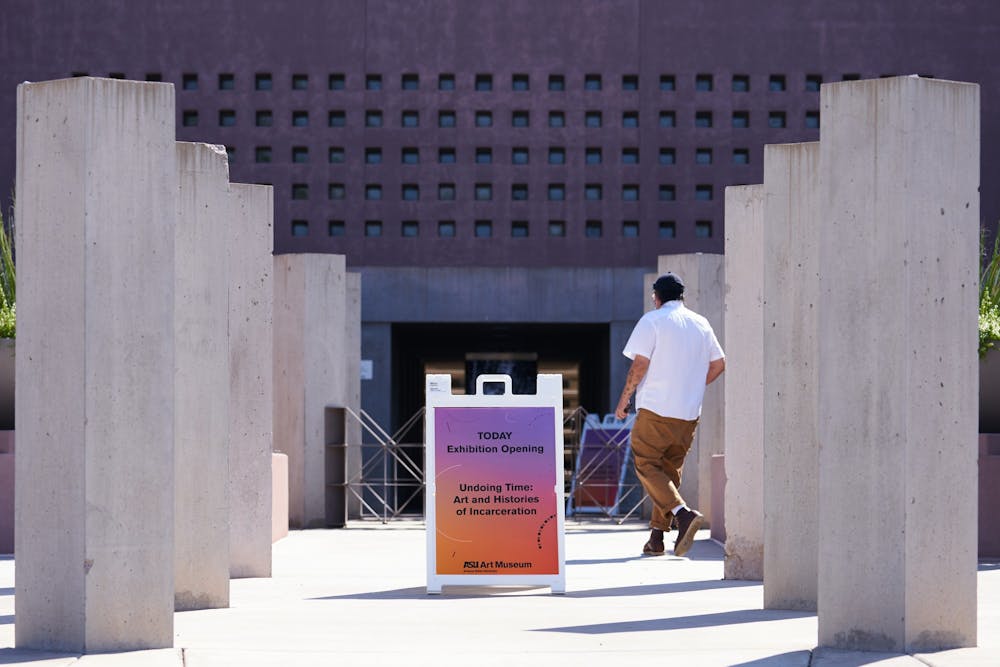The ASU Art Museum opened its “Undoing Time: Art and Histories of Incarceration” exhibition Sept. 10, after years in the making.
The exhibition will be the first ever to utilize all six galleries in the museum, a total of 10,000 square feet. The curatorial team consists of ASU Art Museum director Miki Garcia, curatorial/museum assistant Matthew Villar Miranda, senior curator Julio César Morales and senior curator/associate director Heather Lineberry.
“The subject matter that we're dealing with, I think, really needed that amount of space to sort of tell the story and its essence,” César Morales said.
The exhibition came to fruition with the help of a grant from the Art for Justice Fund that the museum had been invited to apply for.
The ASU Art Museum is the first to receive this grant, and as of now, only two other museums hold it.
The exhibit is a collection of never-before-seen work from 12 artists.
“The idea was somewhat working with artists that work with history as part of their practices and media,” said Villar Miranda. “Oftentimes they use archives or they reappropriate images from the past in their present works.”
The exhibit focuses on mass incarceration and the idea of “new histories,” or as Garcia explained it, the “voices and stories of people who have not been seen or represented or heard.”
In this exhibit, these new histories are of those who have experienced the poor conditions of mass incarceration and communities that have been continually marginalized or victimized by the prison system.
While the exhibit primarily discusses the U.S. prison system, the museum brings in an international perspective with installations by Juan Brenner, who lives and works in Guatemala and focused on the local impact of incarceration, and Stephanie Syjuco, whose work references the history of colonialism and incarceration in the Philippines.
In the U.S., incarceration is an unavoidable topic — according to data from the Prison Policy Institute, while Americans make up just 5% of the global population, incarcerated populations in the U.S. represent 20% of prisoners all over the globe.
Of those incarcerated, in Arizona, the numbers stand out. According to a report by the Vera Institute of Justice, in 2015, over 55,000 people were in Arizona jails and prisons, when the state's total population was just over 6.8 million.
The inequity goes further, with Latine, Indigenous, or Black peoples making up approximately 49% of Arizonans in jail in 2015, despite these communities only making up about 40% of the total population.
"Those are the communities that we felt are probably most affected by the content of the show," said Villar Miranda. "And so a lot of the artists work with Latinx histories, Black histories, Indigenous aesthetics."
Throughout the exhibition, certain pieces pop out more than others. One such piece was “Personal, Small, Medium, Large, Family” by Mario Ybarra Jr., which is modeled after a pizza restaurant.
“Personal, Small, Medium, Large, Family” also explores the impact on loved ones. The artist drew inspiration from personal experience. As a teenager, he had to witness one of his dearest friends, Richard, enter the prison system.
“(Incarceration) really does affect the personal relationships of those folks, the small and radiating circles out," Ybarra Jr. said. He said the communities the incarcerated are taken from and those they make in prison create those medium and large circles.
Ybarra designed the installation after a restaurant he would eat at with Richard. There was also a video element, Ybarra’s interview with a recently paroled Richard.
Ybarra Jr. searched for exhibitions that would display this installation; though those efforts “never stuck,” they came to fruition when he was contacted by the ASU Art Museum.
“In hindsight, I'm glad it wasn't the right moment because my friend Richard wouldn't have been released from prison and wouldn't have been able to participate in the same way.”
“Multi-ples Capas (Multiple Layers)” by Carolina Aranibar-Fernandes can be found in Gallery Five.
“Multi-ples Capas” is an interactive multimedia installation with hanging planters filled with plants thought to have healing properties hanging over an adobe tile floor, which crumbles over time.
"The piece is about the different forms of incarceration, but also all the companies that have been involved historically, contemporarily, in benefiting from the carceral system," Aranibar-Fernandes said. The tiles have the names of companies involved with the prison system.
“Everyone should leave feeling a whole range of feelings that comes with incarceration, trauma, rage, sadness," Villar Miranda said. "We feel like these artists and artworks do that,"
Audiences can also attend upcoming programming at the exhibit, Garcia said. “We have a really robust set of programs that we're hoping we get a lot of people to participate in, people who may not be interested in art, per se, but have a real interest in this theme.”
Reach the reporter at srkrish5@asu.edu and follow @shradhakrish on Twitter.
Like The State Press on Facebook and follow @statepress on Twitter.
Continue supporting student journalism and donate to The State Press today.




